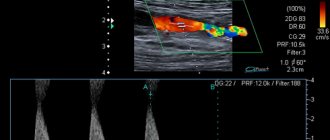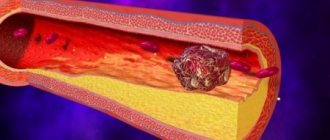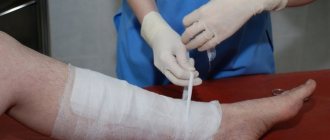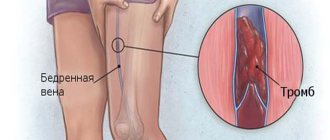The human body is characterized by thrombosis of veins in the lower extremities. Superficial or deep vessels may overlap. If there is a complete blockage of the lumen, then they speak of acute thrombosis. A phlebologist treats the pathological process
, however, urgent operations are performed by a doctor with a profile in vascular surgery. Thrombosis is dangerous not only due to the formation of local dystrophic and necrotic changes, but also due to the separation of blood clots with subsequent blockage of the branches of the pulmonary artery.
Why does vein thrombosis occur?
Patients with thrombosis most often go to the doctor in the last stages of progression of the pathology. However, this disease is always a consequence of certain causes, the consideration of which allows us to reduce the number of clinical cases. Deep veins are affected due to the following factors:
- congenital anatomical abnormalities of the venous vessels or blood coagulation system;
- oncological pathologies;
- endocrine diseases (most often this means disruptions in sex hormones);
- excessive body weight;
- postoperative complications;
- serious fractures (the person does not move for a long time);
- paralytic lesions of the lower extremities;
- some infectious processes (sepsis, pneumonia, abscesses of various origins).
In addition, people over 40 years of age who move little at work, often take long flights, smoke or engage in heavy physical activity are at risk.
If blockage of the superficial veins occurs, which is more typical for women, then the following reasons should be assumed:
- varicose veins of the lower extremities (the main cause of pathology);
- blood diseases;
- infectious processes;
- traumatic injuries or burns;
- pathologies of an allergic and autoimmune nature;
- cardiovascular diseases;
- metabolic diseases;
- pathological processes in the lungs.
Very often, patients with thrombosis consult a doctor if there is a complication such as thrombophlebitis. This condition occurs due to an increased risk of infection in the affected area of the lower limb.
Causes of pathology
In order for the treatment of thrombosis to be most effective, and subsequently to avoid relapses, it is necessary to know the reasons why this pathology may occur. Knowing them, you can direct therapy in the right direction and take preventive measures to protect yourself in the future.
Phlebeurysm
With this disease, the blood thickens and slows down its circulation, resulting in stagnation, which subsequently leads to the formation of blood clots.
In this case, we can talk about thrombophlebitis - a type of thrombosis that is caused by an inflammatory process.
Diseases of the circulatory system
If a patient has diseases such as hemophilia, thrombophilia, erythrimia, the composition and condition of the blood is disturbed, which is a predisposing factor to the formation of clots.
Infectious diseases
Pathogens can cause damage to the lining of the veins, which in turn can lead to the formation of blood clots.
Injuries
Any damage to the blood vessels, be it a cut, burn or surgery, can also become a provoking factor for thrombosis.
Chronic autoimmune pathologies
With such diseases, antibodies are often produced that negatively affect the condition of the veins.
Allergy
With a long and intense course of allergies, substances can be released that negatively affect the circulatory system as a whole.
Metabolic disorder
Diseases that cause metabolic disorders can lead to increased levels of fibrin and fibrinogen, which are the “culprits” for the formation of blood clots.
Cardiovascular diseases
Some cardiac pathologies, such as ischemia, arrhythmia, hypertension or atherosclerosis, can slow blood circulation, which can cause vascular thrombosis.
Lung diseases
The amount of oxygen entering the lungs directly affects the rate of blood circulation and the saturation of body cells with nutrients. With pathologies of the lungs, the amount of incoming oxygen decreases, and therefore the speed of blood circulation decreases, and clots appear.
In addition, risk groups can be separately identified, which indicate the possible likelihood of the formation of this disease. Factors that can prematurely provoke vein thrombosis include:
- bad habits (especially smoking);
- excess body weight;
- sedentary, mostly sedentary or recumbent lifestyle;
- for women, taking oral contraceptives;
- pregnancy;
- elderly age.
If the patient knows that he is at risk, it is much easier to prevent the disease, and then he will not have to treat it later. You just need to take care of your own health: reconsider your lifestyle, completely or at least partially give up bad habits, engage in active recreation, etc.
How to identify the disease?
Doctors describe several main symptoms indicating thrombosis of the veins of the lower extremities:
- a feeling of heaviness in the legs, which worsens after physical activity and in the evening;
- feeling of fullness in the lower legs;
- pain syndrome that radiates to the entire leg, sometimes affecting the perineum and lower back;
- paresthesia (pins and needles sensations, numbness, burning sensation in the limb);
- increase in leg volume (widespread swelling);
- paleness of the skin, sometimes with a cyanotic tint over the affected area;
- increased local and sometimes general temperature (especially characteristic of thrombophlebitis);
- protrusion of the saphenous veins due to overflow of deep vessels;
- coldness of the limb in comparison with a healthy one.
Patients often require a doctor to treat thrombophlebitis, an inflammatory process at the site of thrombosis. This pathology is characterized by redness, severe swelling and increased temperature. Sometimes foci with trophic ulcers form
which become infected and bleed. The pain intensifies significantly. The condition requires immediate intervention by a professional doctor.
Prognosis and prevention
With early treatment and prevention of complications, the prognosis is favorable. Vascular pathologies today are successfully treated with conservative and surgical methods, while maintaining the patient’s high quality of life.
Vascular diseases are best prevented by using medications that lower cholesterol levels, as well as products that contain polyunsaturated fatty acids that can prevent the development of atherosclerosis. It is recommended to adhere to the principles of a healthy diet, do not consume fatty and fried foods, and alcohol. It is advisable to quit smoking and start exercising to strengthen the heart muscle and prevent the development of many diseases, including obesity and hypertension. Moderate physical activity has a positive effect on the entire cardiovascular system.
After 30-35 years, check your cholesterol levels and monitor your blood pressure numbers. If symptoms of vascular disorders appear, begin treatment promptly before complete damage to the arteries and veins occurs.
Features of diagnosing thrombosis at a doctor’s appointment
When visiting a qualified doctor, the patient tells all the nuances of the development of the pathological process, points out predisposing factors (the doctor asks leading questions). Then an initial examination is carried out, which already allows one to suspect thrombosis.
deep veins of the lower limb. When a highly specialized doctor (phlebologist, vascular surgeon) deals with vein thrombosis, he is obliged to carry out the following diagnostic methods:
- various functional tests (Marsh, Pratt, Homans and so on);
- Dopplerography (ultrasound examination);
- angiography (invasive examination of blood vessels).
The latter method is the “gold standard” for vascular doctors. It allows you to make a final diagnosis, clarify the location and size of the blood clot, and select the most effective treatment method.
How does a doctor treat thrombosis?
Therapeutic measures completely depend on the neglect of the pathological process. Thrombosis is treated by a doctor using both conservative and surgical methods. Medicines that thin the blood and help resolve blood clots must be used.
Endoscopic manipulation is considered effective, during which the blood clot is removed. In advanced cases, it is necessary to perform resection of the venous vessels.
If a patient develops inflammation, then drastic methods of solving the problem are required. Thrombophlebitis is treated by a doctor with the use of antibacterial drugs and surgical procedures. To avoid such invasive intervention, it is recommended to study materials on the prevention of thrombosis or visit a doctor who will write down the recommendations.
Save the link, or share useful information on social media. networks
Swelling of the leg, redness of the skin, sharp pain, and increased body temperature can be signs of a blood clot. Such symptoms cannot be ignored. An advanced disease is much more difficult to cure. At the first symptoms, you need to contact a specialist such as a phlebologist. A specialized physician will determine the cause of the pathology and prescribe treatment.
Comments
— @mamajul, orthopedic traumatologist maybe
— I just need to make an appointment for the child, but I don’t see an orthopedist on the list of doctors, so I’m thinking, maybe they call him something else
— @mamajul, and in my clinic, not all doctors are on the list, some are not there and you have to sign up through the registry
— @alver84 huh? I didn’t even think that this could happen! I'll ask at the reception, thanks!
Read these posts in Mamlife - the most popular application for female communication!
A surgeon is a doctor who specializes in the diagnosis and surgical treatment of diseases and injuries.
When should you go to the doctor?
Junk food, stress, sedentary work, and a sedentary lifestyle can trigger the occurrence of thrombophlebitis. The disease manifests itself in acute and chronic forms. With thrombosis of the lower extremities, heaviness is felt in the legs, swelling appears, and the color of the skin in the affected area changes. In addition, the veins swell and sharp pain occurs, especially upon palpation. If discomfort in the legs has become regular and is constantly progressing, the veins are dilated, and vascular formations in the form of stars are visible on the skin, you need to go to the hospital as soon as possible. You should not ignore night cramps, increased fatigue, and swelling that appears in the evening and disappears in the morning.
A clot along with blood can move through the vein, interfering with the normal functioning of vital organs.
How does a doctor treat thrombophlebitis?
First of all, the doctor will examine the legs, paying attention to the area where the problem occurred. After this, the doctor prescribes examinations. Modern equipment makes it possible to diagnose thrombosis, thrombophlebitis, varicose veins and other vascular diseases. In addition, the location of the blood clot, the severity of the disease, and possible associated problems can be determined. Depending on the research results, the doctor determines the correct choice of therapy.
There are several treatment methods:
- drug therapy;
- radical measures;
- minimally invasive method.
At an early stage of the disease, drugs are prescribed that together lead to positive results. These include:
- painkillers;
- anti-inflammatory;
- angioprotective agents that restore blood circulation;
- enzyme preparations;
- blood thinning agents;
- local agents.
With a minimally invasive approach, an implant is installed in a vein, which acts as a filter. Surgery is a radical method in which part of a vein or vessel is removed. The method of treatment depends on the degree and severity of the disease. A phlebologist diagnoses diseases of the lower extremities at all stages, selects ways to influence a blood clot, and conducts a conversation about possible prevention.
Thrombophlebitis is a pathology accompanied by the formation of blood clots in the veins, interfering with blood flow. Most often, this disorder affects the patient’s lower extremities. Deep veins are susceptible to damage, but sometimes superficial veins are also affected. The disease is very dangerous due to the possibility of blockage of the pulmonary vein.
And this condition is fraught with pulmonary thromboembolism. It is also aggravated by the fact that many people ignore the symptoms of lower limb health problems for a long time and turn to a specialist as a last resort. Often this is caused not only by indifference or fear, but also by the fact that people do not know which doctor treats thrombophlebitis of the lower extremities. Venous diseases can be cured by a phlebologist, but operations in this area are performed by a vascular surgeon.
It is not worth solving the problem on your own, because a person’s lack of awareness in the field of vascular diseases can lead to dire consequences.
Not many people know which doctor to contact for thrombophlebitis, and not all hospitals have such a doctor. This is a narrow specialty aimed at treating problems with veins. If there is no such specialist nearby, you should make an appointment with a surgeon. The ideal option would be a vascular surgeon, because phlebitis is one of the areas of his work. In medicine, there is a direction that studies the pathology and anatomy of the blood vessels of the legs. Some clinics practice an integrated approach to therapy, with the participation of both specialists. It includes the following measures:
- The surgeon treats only in emergency cases through surgery: he performs vein removal and other surgical interventions related to this area.
- Phlebologists provide drug therapy, accompany the rehabilitation period, and, if necessary, provide consultations on the prevention of such diseases.
In this case, a lot depends on the experience of specialists. The importance of the surgeon in this is quite important, because in advanced stages, urgent intervention is needed, and medications will not bring the desired result. If treatment is carried out on time, problems with blood vessels will not affect the person, and they can be very dangerous not only for general health, but also for life.
What's in this article:
Who will replace the podiatrist?
If there is no podiatrist in your city, a doctor from the clinic or a manicure-pedicure specialist will help with some foot problems.
Who to choose depends on the type of violation:
- calluses – pedicurist;
- onychomycosis – dermatologist, mycologist;
- ingrown toenail – surgeon;
- flat feet and other types of foot deformities - orthopedist, traumatologist;
- diabetic foot – endocrinologist, surgeon, neurologist.
But when contacting them, you should not count on comprehensive treatment, clarification of the cause of violations, or measures to prevent relapse. Doctors will help relieve the acute condition, remove pain, inflammation, but no more. In the absence of a podiatrist, it is most difficult for people with several problems at once, since in this case it is not clear where to turn first.
For example, nail fungus or ingrown toenail due to diabetes.
It is easy to understand how the approach of a doctor and a podologist differs, using the example of treating an ingrown toenail. The surgeon will simply remove the nail or a significant part of it, which will result in an unpleasant rehabilitation with an unknown result.
After all, after such treatment, the likelihood of relapse will be high. Unlike a surgeon, a podiatrist will install a bracket or a correction plate on the nail, which will correct the direction of growth and relieve pressure on the sore spot. The procedure will be painless, and the nail plate will be preserved as much as possible. The podiatrist will also find out the cause of ingrown toenails, advise on how to change nail care, and choose shoes so that the situation does not recur in the future.
In what cases should you contact a phlebologist?
Pathology can occur in two forms - acute and chronic. In an acute disease, development occurs rather slowly and has periods of exacerbation.
For a person, it passes almost unnoticed; in most cases, the malaise is attributed to fatigue. Sometimes the symptoms are caused by an injured leg. It is important to know which doctor to contact if you have a blood clot in your leg.
At the first signs of illness, you should contact a specialist for diagnosis and therapy. In order to begin treatment measures in a timely manner, you should know what signs indicate vascular diseases of the lower extremities, in particular thrombophlebitis.
The presence of at least one worrying sign on a regular basis should be a cause for concern and contact a medical facility.
At the local level, the disease manifests itself as follows:
- painful sensations in the vein that worsen with physical activity;
- movements are constrained due to pain;
- the affected vein turns red and enlarges as the disease progresses. With this disease, there is no severe swelling of the legs in the affected area;
- the affected vessel feels like a hard cord to the touch due to severe inflammation;
- the general body temperature begins to rise, and in addition the temperature of the affected area also rises;
- Quite often, patients experience general malaise and chills throughout the body.
With this pathology, migration is possible, that is, a blood clot can break away from the vascular wall and cause blockage of the pulmonary artery, which can result in a pulmonary embolism. The pathology is dangerous with a high probability of death in case of late contact with a specialist or complete ignoring of the disease.
The signs listed above may also be present in chronic form only during exacerbation. In the absence of exacerbation, they do not appear at all.
Types of pathology
Venous thrombosis does not have a strictly defined classification, but it can be divided into acute and chronic. In the first case, we can talk about a sudden illness that has all the characteristic symptoms. In the second case, the ailments are episodic: pain, heaviness and fatigue in the affected area occur from time to time.
Signs of pathology most clearly appear if acute thrombosis occurs. The patient's body temperature rises, but the diseased part of the body remains cold, and the pain seems to burst from the inside. In this case, you should immediately consult a doctor without taking any action to eliminate the symptoms or prevent complications.
Chronic thrombosis, on the contrary, in most cases does not show obvious signs of the disease, and therefore the patient may postpone visiting a doctor. However, it is still necessary to consult a specialist, since the absence of any treatment can lead to irreparable complications. Chronic thrombosis is usually treated with topical medications.
Despite the fact that most often blood clots form in the veins of the lower extremities, they can appear in any part of the periphery of the venous bed.
The causes and treatments for the disease will vary depending on the location of the blood clot. Thrombosis of superficial and deep veins can also be distinguished: in the first case, the disease occurs with moderate symptoms and is easier to treat, and in the second case, the patient faces more complications.
Diagnosis methods
In order to determine the correct diagnosis, an experienced doctor will only need a palpation method at the first stage of the examination. The further direction of diagnosis will depend on the results of palpation.
Confirmation or refutation of the diagnosis can be made by additional diagnostics in the form of ultrasound or other methods to monitor the condition of the vessels and the location of the lesion.
You need to know when your health requires special care in the form of regular examinations. The condition of blood vessels is influenced daily by several factors. In particular this:
- The poor state of the ecology of the modern world.
- Being under constant stress.
- Large amounts of time in a sitting position.
- A large number of harmful foods in the daily diet.
The course of disease therapy is largely determined by the patient’s lifestyle and individual characteristics. Most often, problems with the vessels of the lower extremities occur in women because they wear uncomfortable high-heeled shoes or very narrow ones. This has a detrimental effect on blood vessels and has a number of consequences in the form of varicose veins and thrombophlebitis.
In particular, a consultation with a phlebologist will help determine the extent of problems with blood vessels and differentiate the pathology. This is necessary not only for the treatment of thrombophlebitis, but also other equally dangerous vascular disorders.
In general, it is recommended to contact this specialist if the patient complains of:
- frequent pain of a bursting nature;
- constant heaviness in the calves;
- swelling and redness in the feet at the end of the day;
- the presence of spider veins on the skin;
- dilation of blood vessels and veins;
- night cramps;
- damage to the skin or subcutaneous layer of thrombophlebic origin.
In addition to thrombophlebitis, this doctor also treats other pathologies, including thrombosis, varicose veins, trophic ulcers on the skin, venous insufficiency, and spider veins.
Modern equipment guarantees almost 100% accuracy of diagnosis. In addition, diagnostics is aimed at identifying pathologies that occur in parallel with the underlying disease.
Traditional medicine prescriptions are also actively prescribed, but only after approval by a specialist.
Endocrinologist
This doctor will also help with heavy sweating. And vascular networks on the thighs are often the result of a hormonal imbalance in the female body, and not varicose veins, as many people think.
This is where a gynecologist-endocrinologist will come to the rescue. Perhaps you are taking oral contraceptives (OC), then you need to know that they do not have a very good effect on the venous wall and can cause dilation of intradermal vessels. Pregnancy and gynecological diseases can also lead to this problem. The doctor will tell you how to preserve the beauty and health of your feet.
Now you know what kind of doctors there are and what leg diseases they treat, which means it will be easier for you to navigate the complex medical world.
Not everyone knows what a leg vein doctor is called. If you start having problems with your legs, for example, spider veins and veins appear on them, it means that your health is at risk and you need to urgently consult a phlebologist. The first symptoms that will confirm your guesses about the presence of the disease will be dilated blood vessels. It is the deformation of the veins that provokes varicose veins, which from a small problem can become a serious pathology, and you will definitely have to go to the clinic for it.
Treatment methods for thrombophlebitis
Therapeutic measures for such a disease are complex, because this is the only way to completely get rid of it. Modern medicine offers many methods for treating this pathology with minimal health risks. Of course, this largely depends on the time when the patient sought specialized help, because a large number of opportunities can be lost due to treatment at a late stage.
Treatment includes three groups of techniques: conservative involves medication therapy and is used at an early stage of the disease. Surgical intervention is used in therapy only in cases of urgent need. With the help of minimally invasive means, the body is not subjected to open intervention, but through internal manipulation. With their help, the movement of a blood clot is blocked by placing a special implant in the vein.
Medications do not act radically on the body, gradually eliminating the problem. Most often used for such therapy:
- Medicines that relieve pain.
- Means that remove the inflammatory process.
- Medicines that restore tissue of vascular walls.
- Enzyme agents.
- Ointments and creams for topical use.
- Disaggregants.
If the lesion is deep, therapeutic measures should take place in a hospital setting so that the doctor constantly monitors the dynamics of the patient’s condition. It is especially important to take preventive measures. They are divided into two groups: specific and non-specific. Specific medications include medications, and nonspecific prevention includes restoring balances in the body and normalizing blood condition. Primary prevention consists of eliminating harmful factors that influence the occurrence of the disease. First of all, this means giving up bad habits and leading an active lifestyle. This is especially important if there is a genetic predisposition to this disorder. Additionally, you can use diuretic herbs for edema. They will be useful even for preventive purposes.
How to cure thrombophlebitis of the lower extremities is described in the video in this article.
A lot of information about thrombophlebitis of the veins of the lower extremities: symptoms, principles of treatment, complications.
The consequences of the disease are serious. At the first sign, you should seek professional help. A phlebologist treats diseases of the veins of the lower extremities.
Not all hospitals provide consultations and treatment with a doctor of this specialization. Phlebologist is a narrow specialization of a doctor who deals exclusively with the treatment of problems associated with the veins of the lower extremities and other parts of the body. In the absence of a practicing phlebologist, you should go to an appointment with a surgeon, preferably a vascular one. They treat vein problems, including thrombophlebitis.
A direction in medicine has been identified that deals with such issues, studying in detail the anatomy of the veins of the lower extremities and other parts of the body. Some clinics practice complex treatment of diseases of the veins of the lower extremities:
- The surgeon removes veins and performs operations.
- A phlebologist treats venous problems with medications, guides the rehabilitation period, and provides consultations indicating preventive measures.
When dividing treatment, the experience of doctors plays a role. With timely and proper treatment, problems with blood vessels and the consequences of thrombophlebitis can be avoided.
Cerebral atherosclerosis
(from the Greek ἀθέρος - chaff, gruel + σκληρός - hard, dense) is a disease that affects the arteries of the brain. The disease occurs in people over the age of 20, but most often it affects older people (over 60 years of age). Cerebral atherosclerosis is a type of vascular dementia (dementia), which is why it is sometimes called “senile sclerosis.”
Causes
Causes of the disease:
- unhealthy diet (excessive consumption of animal fats); increased production of cholesterol by the liver; frequent stress; alcohol abuse.
Symptoms
Symptoms of senile sclerosis do not always appear at the initial stage of the disease, so older people need to periodically undergo a complete examination. The clinical picture of symptoms characteristic of cerebral atherosclerosis is as follows:
- progressive memory impairment; weakening of attention and concentration; impaired coordination of movements; sleep disorders; decreased mental performance; rapid mood changes; frequent headaches; depressive state.
Diagnostics
To determine how to treat cerebral atherosclerosis. A neurologist prescribes tests:
- immunological blood test lipid profile (blood test for cholesterol levels) ultrasound examination of internal organs angiography (X-ray of blood vessels) magnetic resonance imaging of the brain Dopplerography of blood vessels
Treatment
For the treatment of cerebral atherosclerosis the following are used:
- drugs with lipotropic and hypocholesterolemic effects;
- drugs that reduce vascular inflammation;
- vasodilators;
- drugs that improve the cardiovascular system and cerebral circulation;
- multivitamins.
Surgical intervention is possible to remove excess cholesterol from the blood:
- cryoapheresis (plasma purification);
- cascade plasma filtration.
Diet
for senile sclerosis: It is necessary to exclude foods containing cholesterol from the diet:
- fatty dairy products (over 1% fat content);
- fatty meats;
- sugar;
- confectionery.
Complications
What will happen if cerebral atherosclerosis is not treated in time: Untimely treatment of cerebral atherosclerosis can lead to dangerous complications:
- stroke;
- heart attack;
- paralysis;
- death.
At-risk groups
Cerebral atherosclerosis - who is more at risk of getting sick: The disease occurs in people over the age of 20, but most often it affects older people after 60 years. Cerebral atherosclerosis is a type of vascular dementia (dementia), which is why it is also called senile sclerosis.
Prevention
- walks in the open air;
- do not abuse foods containing cholesterol;
- to give up smoking;
- do not drink alcohol;
- do physical exercise daily.
This article was compiled using reference medical publications and materials from open Internet sources. It is published for educational purposes only and does not constitute scientific material or professional medical advice.
Literature: Wikipedia: atherosclerosis Medical encyclopedia: atherosclerosis Look for the term “cerebral atherosclerosis” in dictionaries and encyclopedias Do not self-medicate, diagnosis and treatment of diseases should be performed by an experienced professional doctor!
When to seek treatment
Thrombophlebitis of the lower extremities is presented in two forms:
In the first case, the disease manifests itself and progresses for no apparent reason. Sometimes we are talking about a trauma that precedes the disease.
Manifestations of the disease are local in nature and are expressed by external changes:
- Pain along the vein, increasing with movement.
- Stiffness in movement due to pain.
- Redness in the area of the affected vein, increasing as it progresses. Thrombophlebitis is not characterized by swelling of the affected area.
- Due to inflammation, the affected vein becomes dense and resembles a cord to the touch.
- In the affected area, body temperature increases, and overall temperature rises.
- Often malaise, chills.
Thrombophlebitis is dangerous due to migration, separation of a blood clot from the walls of the affected vessel. Leads to the entry of a clot into the deep veins, the development of pulmonary embolism. The disease is often fatal.
Chronic disease lasts a long time, with periodic exacerbations of the condition. At the time of exacerbation, the listed symptoms are observed. During periods of calm, external signs may not be present.
When to visit a doctor
Today's lifestyle involves stress on the body, especially the vessels of the lower extremities. Factors provoking varicose veins, thrombophlebitis:
- Bad ecology;
- Stressful situations;
- Time spent sitting at the computer, watching TV;
- Wrong nutrition.
Treatment of the disease depends on the characteristics of the body and the person’s lifestyle. Often thrombophlebitis and varicose veins occur in women, the reason is wearing narrow shoes or high-heeled models.
Consultation with a phlebologist is required if there are signs:
- Pain in the legs of a constant, bursting nature.
- Feeling of heaviness in the calves.
- By the end of the day, there is swelling and redness in the area of the feet and lower extremities.
- Vascular formations in the form of stars appear on the skin.
- Dilatation of blood vessels and veins occurs.
- Cramps occur periodically, especially at night.
- Signs of damage to the skin and subcutaneous layer, which are thrombophlebic in nature.
At the first consultation, the phlebologist will examine the condition of the patient’s veins. Based on the results, it is decided whether additional laboratory and hardware examinations will be required.
The phlebologist’s competence includes treatment of other pathologies:
- Trophic ulcers on the skin;
- Phlebeurysm;
- Spider veins;
- Thrombosis;
- Venous insufficiency.
Thanks to the latest equipment, a vascular surgeon accurately diagnoses venous disease, identifies pathologies present in the body and developing in parallel with the underlying disease. For treatment, the phlebologist prescribes consultations with doctors for the patient.
A favorable treatment outcome depends on timely consultation with a doctor. Self-treatment is prohibited - it delays going to the doctor and does not bring improvement. It is not forbidden to use folk recipes, but agree with a phlebologist.
Traumatologist-orthopedist
Deals with injuries and their consequences. The competence of a traumatologist includes flat feet, deforming arthrosis, and curvature of the spine.
Treatment methods range from foot massage and a complex of physical therapy to complex surgical interventions. The wearing of orthopedic shoes, special stockings, and insoles is prescribed. The method is chosen individually.
Cases of contacting an orthopedic traumatologist:
- The leg hurts after a traumatic impact - sprain, soft tissue bruise, bone fracture.
- Impaired range of motion in the joints of one leg.
- Enlargement and swelling of one joint after injury.











